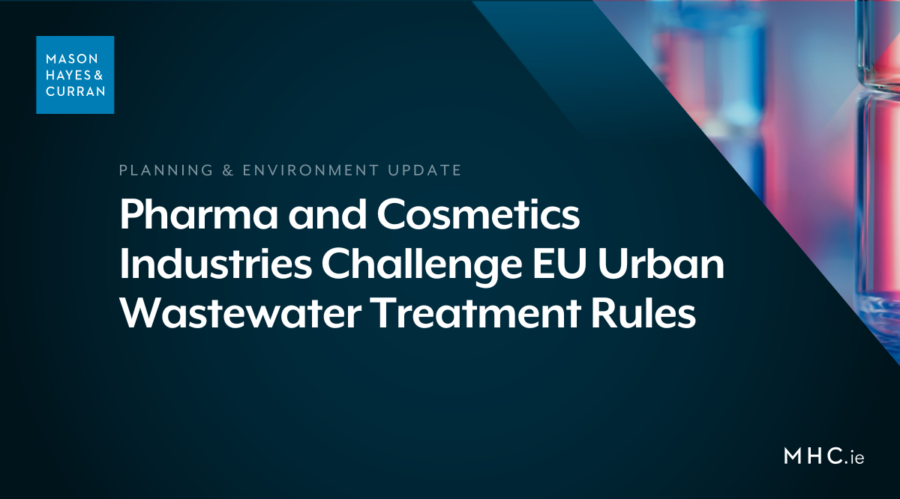Pharma and Cosmetics Industries Challenge EU Urban Wastewater Treatment Rules

The pharma and cosmetics industries have brought legal challenges against the EU’s proposed urban wastewater treatment rules. Our Planning & Environment team discusses the new rules, the legal challenges taken against them, and provides practical steps that industry can take to engage with Member States on their implementation.
What you need to know
- The new rules would require the pharmaceutical and cosmetics sectors to pay at least 80% of the costs of the enhanced treatment.
- Companies and associations are advocating for the sharing of responsibility across all polluting sectors. They argue that the new rules are disproportionate, discriminatory, and in breach of EU law.
- Industry has an opportunity to engage with Member States on the implementation of the new rules.
The pharmaceutical and cosmetics industries have brought legal challenges against the EU’s proposed rules requiring them to pay for enhanced treatment of urban wastewater. Under the revised Urban Wastewater Treatment Directive, producers that place certain medicinal or cosmetics products on the Irish market must contribute at least 80% of the costs of treatment of micropollutants in wastewater. These industries have argued that others should also be required to contribute to these costs. We discuss the Directive, the legal challenges taken against it, and how industry can prepare for its impacts and engage with national governments in advance of its implementation.
The revised Directive
In our previous article, we discussed revisions to the Directive that require the pharmaceutical and cosmetics industries to pay for the removal of micropollutants from urban wastewater. In summary, Ireland must establish an extended producer responsibility, or "EPR", scheme to fund the enhanced treatment of micropollutants by 31 December 2028. Certain producers that place specified medicinal or cosmetics products on the Irish market must contribute at least 80% of treatment costs. “Producers” include:
- Manufacturers
- Importers
- Distributors, and
- Distance sellers
Other amendments to the Directive include:
- Extending its scope to a greater amount and type of pollutants, and
- Requiring Ireland to apply an additional treatment known as “quaternary treatment” to certain urban wastewater discharges. This treatment will be funded by the EPR scheme.
Legal challenges
The revised Directive has been met with significant pushback from the pharmaceutical and cosmetics industries, as well as several EU Member States. It’s been reported that several countries have written to the European Council to express concern about the potential for costs to be passed from industry to consumers and healthcare systems.
Poland has referred the Directive to the Court of Justice of the EU. Poland also argues that the measure violates the principles of equal treatment and proportionality. It claims that the responsibility for enhanced treatment of wastewater shouldn’t be placed solely on the pharmaceutical and cosmetics industries. Instead, the scheme should include other industries that also contribute to pollutants in urban wastewater.
Companies and industry groups have taken challenges on similar grounds. Medicines for Europe released a statement supporting its members in their case. The group notes that the action seeks to “avoid a discriminatory and disproportionate cost burden” and “safeguard patient access to vital medicines”. Similarly, the EFPIA has argued that the costs of treatment should be evenly shared by all polluters, and that to do otherwise would impact patient access to medicines. AESGP has called for a 20% contribution from the public sector to cover the costs of untraceable micropollutants that EU citizens are using.
What can industry do?
Ireland has until 31 July 2027 to implement the Directive into national law. Generally, Member States have some discretion in how they achieve outcomes prescribed by directives. This means that Member States may try to reduce or increase the impact of the Directive on producers through national law.
Producers are entitled to engage with governments on the implementation of national legislation. Here are some areas that producers should be aware of.
Mandatory dialogue
The Directive aims to ensure that the EPR system is implemented as optimally as possible, in particular from a cost-benefit perspective. To achieve this, Member States must maintain regular dialogue with stakeholders, including producers amongst others, on its implementation.
Topics may include identifying measures to be taken by competent authorities to:
- Reduce micropollutant pressure at source
- Determine the most appropriate technologies for quaternary treatment, and
- Identify inefficiencies and reduce the energy requirements of urban wastewater treatment plants
- Ensure a national EPR scheme is implemented as optimally as possible
This mandatory dialogue could provide producers with a valuable opportunity to seek to reduce those costs such as by innovative design and technology in collaboration with Member States and other stakeholders.
Accessibility, availability, and affordability
Industry could highlight the importance of considering the impact of national EPR systems on the “accessibility, availability, and affordability of products at national level, in particular medicines”. It could also highlight the possible impacts of EPR on the level playing field, as stated by the Directive.
The Directive also states that “Member States can take action to ensure sufficient funds are available, including by financing part of the costs for the quaternary treatment” and that the costs borne by industry should be “complemented by other types of financing.”
This suggests that Member States have scope to reduce the impact of the EPR requirements on producers by part-funding the cost of quaternary treatment themselves. Producers may want to provide evidence to Member States about the potential impacts on ‘the accessibility, availability, and affordability of products.’ This could be shared as part of the stakeholder engagement process, and could help producers understand the extent to which their Member State will consider these impacts and part-fund the cost of the treatment.
Information exchange
Under the Directive, the European Commission is required to provide for an exchange of information, experience and best practices concerning national EPR schemes by 1 January 2025. This information exchange includes topics such as the possible impacts of EPR on the accessibility, availability, and affordability of medicines placed on the EU market.
The Commission must publish the results of this exchange and can provide recommendations to Member States. This may offer further clarity on the extent of Member States’ scope to mitigate the impacts of EPR.
Reformulation
The financial contribution that each producer must make to a national EPR scheme will be calculated based on the quantities and hazardousness of the substances contained in the producer’s products that are placed on the market. Producers may want to consider reformulating their products to reduce their financial contribution.
Producers should assess the hazardousness of their products and their potential to give rise to the release of micropollutants into urban wastewater. This assessment could identify areas where micropollutants could be replaced with alternatives.
Expanding the scope
The final area around which the pharmaceutical and cosmetic industries could lobby is expanding the scope of EPR schemes to include other polluting industries. The Directive recommends that the ongoing monitoring of urban wastewater and scientific data should be used by the Commission to “regularly evaluate whether other products should be included in the extended producer responsibility system”. If verifiable data shows that other industries are responsible, this could provide producers of medicinal and cosmetics products with a basis to engage with the EU to broaden the scope of products that the EPR scheme applies to.
Proposed ban on forever chemicals
Finally, as noted in our previous article, the revised Directive requires that Member States monitor per- and polyfluoroalkyl substances (PFAS), also known as “forever chemicals”, at the inlet and outlet of wastewater treatment plants. Separately, the European Chemicals Agency (ECHA) is considering a proposal to ban PFAS on the EU market. It is expected to make a recommendation to the European Commission in 2025 on whether a ban, or limited restrictions, or derogations should be introduced. The ECHA met in March 2025 to progress its evaluation of the proposed restriction on PFAS. Notably, the Agency announced that it will evaluate the medical devices, transport and energy sectors in June.
Comment
It remains to be seen what the impact of the legal challenges taken against the Directive will be. In the meantime, and before EPR schemes are put in place by 31 December 2028, producers have an opportunity to engage with Member States on the implementation of the Directive.
For more information and expert advice, contact a member of our Planning & Environment team.
The content of this article is provided for information purposes only and does not constitute legal or other advice.
Share this:



